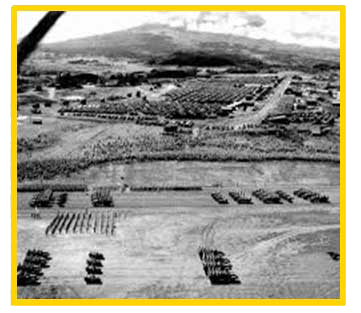





was based on Maui from 1944-45, they also undertook missions to take back four central Pacific islands from the Japanese: Roi-Namur in the Marshall Islands, Saipan and Tinian in the Marianas, and Iwo Jima. Their victories turned the tide of WWII by securing U.S. airstrips within flight range of Tokyo and liberating many Polynesian nations. Between deployments, they rested and trained on the slopes of Haleakala at Camp Maui.
After completing combat training at Camp Pendleton, CA in 1943, over 17,000 Marines, most in their teens, deployed directly to the Marshall Islands. After securing Roi-Namur, their ships arrived on Maui in February 1944. A long convoy of troop trucks wound uphill from Kahului Harbor to 1,600 acres of pasture in upcountry Haiku, where Army engineers had set up over 2,100 tents, and constructed ball fields, movie theaters, mess halls, a post exchange, headquarters buildings and a half-mile long airfield.

Small unit exercises and shooting ranges on Haleakala's sliding volcanic ash, cliffs, caves, gullies and Maui beaches simulated battle conditions on other central Pacific islands.Camp Maui had a demolition area, live grenade course, pistol range, bazooka range, 100-target rifle range, and 1000-yard machine gun range. Over 47 U.S. Army training facilities on Maui were also available to the Marines: including jungle village and cave fighting courses, jungle positions fortified with pillboxes, and emplacements concealed in bamboo forests, banyan tree roots and thick undergrowth. On the seacoast near Ma`alaea Bay were a mortar and artillery impact area and range, anti-aircraft and anti-tank moving target ranges, a close combat range and a 20-point rifle range.
Competitive individual and team sports kept morale high at Camp Maui: baseball, basketball, handball, volleyball, tennis, golf, boxing and football. Lt. Col. Leroy “Pat” Hanley, a former football coach at Boston University, coached the undefeated 4th Marines Division Football Team to six victories, five of which were shutouts. Both Pat Hanley and his star quarterback, that season were later killed in action at Iwo Jima.
Enlisted men were allowed two bottles of beer per night. Movies, magazines, cards, Red Cross recreation tents and an occasional traveling USO show or hula show filled the hours. The 24th Regiment dance band called “Just 4 Fun,” toured Central Pacific officer clubs. Camp Maui had both Officers Club's and an NCO Club's. Lieutenant General Larry Snowden remembers as a young officer, attending parties at the Maui Country Club in Sprecklesville.
Over 20,000 women enlisted in the U.S. Marine Corps during WWII. By war’s end about 1,000 Women Reservists (WRs) were serving in the Territory of Hawai`i – some at Camp Maui. American Red Cross women also worked in recreational huts at Camp Maui, serving coffee and doughnuts every evening.

While awarding Purple Hearts at Camp Maui in April 1944, Admiral Nimitz said,"...the men who fought at Roi and Namur ... wrote another brilliant chapter in the chronicles of the Marine Corps.”
At the end of May 1944, the entire Division again shipped out and defeated the Japanese on Saipan and Tinian. By mid-August, they were back on Maul. In February 1945, the Fighting 4th joined the 3rd and 5th Marine Divisions in the Marianas to rehearse maneuvers before the Battle of Iwo Jima. This famous battle lasted over 36 days and cost more lives than any combat event in U.S. Marine Corps History: The 4th Marines sustained 9,098 casualties; 1806 of these men died. Survivors returned to Maui victorious once more and began training for further operations. When the Japanese surrendered unconditionally 2 months later, the Fighting Forth mustered one lasttime for their return journey. to California by ship. By their victory, the 3rd, 4th and 5th Marine Divisions have made an accounting to their country which only history will be able to value fully.

The VMO-4 aerial observation squadron first activated at the end of 1943 at Quantico, VA and was assigned to the 4th Marine Division on Maui to fly artillery and observation missions over the battles of Saipan, Tinian and Iwo Jima. The squadron's 1/2 mile long airfield in Haiku, also served as a parade ground from time to time.

In four missions, 3,298 Marines lost their lives and 17,722 more were wounded in battle. With the surrender of the Empire of Japan, the 4th Division deactivated and shipped out to California. The former Camp Maui property was returned to the original property owners, and more recently, in the last remaining rainforest and jungle areas of the former Camp Maui the NORTHSHORE ZIPLINE COMPANY has installed a seven-zipline guided tour. Trained guides of the NORTHSHORE ZIPLINE COMPANY stand ready to tell the story of "The mighty Fighting Fourth,” and also offer tours - via zipline - of what remains of Maui's largest WWII historical site.
TO RESERVE YOUR TOUR OF CAMP MAUI VIA - ZIPLINE